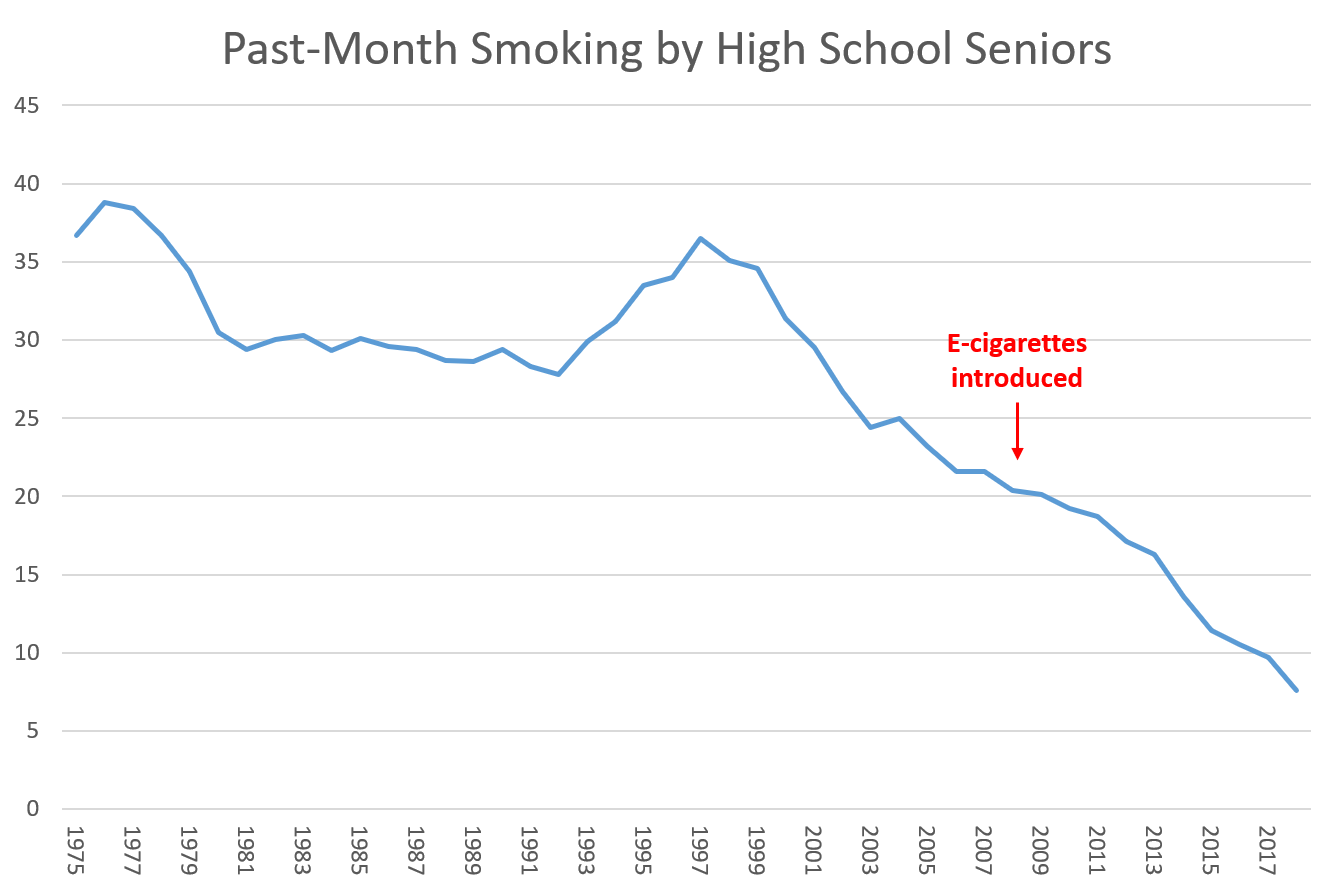Amid the Underage Vaping 'Epidemic,' Adolescent Smoking Again Hits a Record Low
Is e-cigarette use by teenagers a public health disaster or a public health boon?
The latest results from the Monitoring the Future Study, released today, show a jump in vaping by teenagers similar to the one indicated by the National Youth Tobacco Survey numbers published last month. They also show that cigarette smoking by high school seniors, which hit a record low last year, continues to decline.
Since e-cigarettes are far less dangerous than the conventional, combustible kind, the relationship between these two trends is vitally important in evaluating the public health impact of the underage vaping "epidemic." Yet the head of the Food and Drug Administration says his agency, because it is obligated to reduce e-cigarette use by minors at all costs, cannot weigh the possibility that its interventions, which so far include flavor restrictions and anti-vaping propaganda, may result in more smoking-related disease and death.
In the 2018 Monitoring the Future Study, 7.6 percent of 12th-graders reported that they had smoked cigarettes during the previous month. That is the lowest rate ever recorded by the survey, which began in 1975. It is 80 percent lower than the peak rate of 38.8 percent recorded in 1976.
A recent analysis in the journal Tobacco Control, based on data from five national surveys, found that downward trends in smoking by teenagers and young adults accelerated as e-cigarette use in those groups took off. That correlation strongly suggests that young people who would otherwise be smoking are vaping instead, which represents a huge improvement in terms of health risks.

Today's press release from the University of Michigan's Institute for Social Research, which conducts the Monitoring the Future Study under contract with the National Institute on Drug Abuse, does not mention the continuing decline in smoking until the 20th paragraph. Instead it highlights the rise in vaping under the headline "Vaping Surges: Largest Year-to-Year Increase in Substance Use Ever Recorded in the U.S. for 10th and 12th Grade Students." Between 2017 and 2018, past-month vaping of nicotine rose from 11 percent to 20.9 percent among 12th-graders, from 8.2 percent to 16.1 percent among 10th-graders, and from 1.6 percent to 2.6 percent among eighth-graders.
Those are indeed big increases, reflecting the surging popularity of Juul e-cigarettes among teenagers. But judging from the National Youth Tobacco Survey, most of those past-month vapers are using e-cigarettes only occasionally. In that survey, 5.8 percent of high school students, which represents about 845,000 teenagers, reported using e-cigarettes on 20 or more days in the previous month this year. Those frequent e-cigarette users constituted 28 percent of the past-month vapers. The Monitoring the Future Study did not report data for "daily" vaping, but the proportions are probably similar.
How big a problem is it that 845,000 or so teenagers are frequent vapers? To the extent that those teenagers otherwise would be smoking, it is more like a solution than a problem. According to an analysis of data from the 2015 National Youth Tobacco Survey, almost all frequent vapers were current or former smokers, although that breakdown may have changed in recent years as vaping became more common among teenagers. Even for the adolescent vapers who otherwise never would have tried nicotine, the long-term health consequences are likely to be minimal. On balance, the increase in e-cigarette use by teenagers is more likely to be a public health boon than a public health disaster.
Scott Gottlieb, the head of the FDA, acknowledges that "there's a component in there of kids who are using e-cigarettes in lieu of combustible tobacco and otherwise would have used the combustible tobacco." But he adds that "from our standpoint, that's a hard justification for us to use as a public health justification when our mandate is no child should be using a tobacco product." Under the heading of "tobacco product," he includes e-cigarettes, which contain no tobacco and do not burn anything.
In other words, even if e-cigarettes have led to less smoking among teenagers, meaning less tobacco-related morbidity and mortality in decades to come, the FDA sees its mission as fighting that trend, even if it results in more tobacco-related morbidity and mortality. That's leaving aside the impact that the FDA's e-cigarette restrictions will have on adult smokers who are interested in switching to vaping or have already done so, some of whom will be deterred or backslide now that the flavors they prefer are harder to get. Somehow the FDA sees itself as obligated to attack public health in order to promote it.


Show Comments (10)